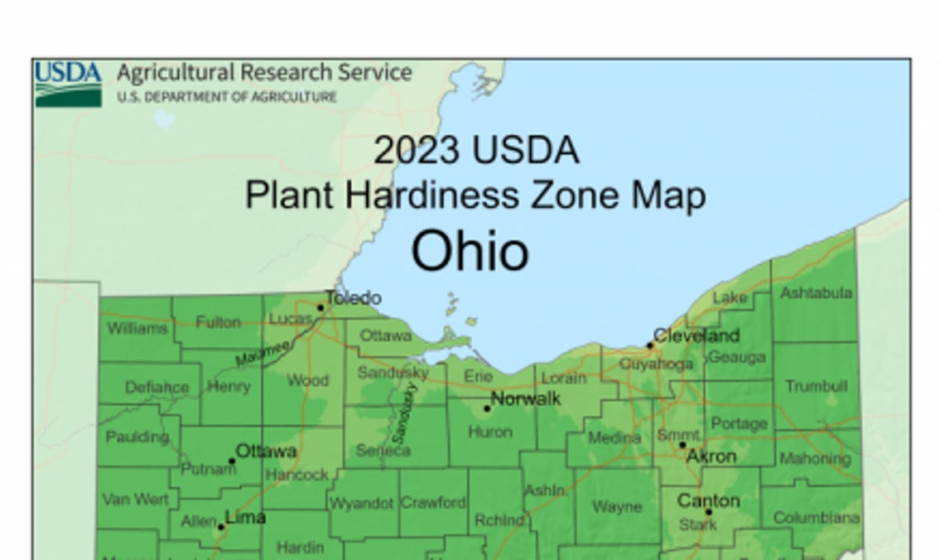Late last November, the United States Department of Agriculture (USDA) released an updated Plant Hardiness Zone map for the United States. Gardeners use this map to determine which plants and specific varieties of plants will thrive in the locations where they garden. This update includes revised maps for each of the 50 states. This is the first time that this national map has been updated since 2012.
The new map is based on 30-year averages of the lowest annual winter temperature in a particular location. The 2023 map incorporates data from 13,412 weather stations around the country compared with the 7,983 that were used for the 2012 map.
Changes to the Ohio map
On the 2012 Plant Hardiness Zone map, Greater Columbus (and a good portion of the rest of Ohio) was in Zone 6a, where the average lowest temperature ranges from -10 to -5 degrees Fahrenheit. In the 2012 edition of the map, there were several locations in Ohio that were in Zone 5b, where average lowest temperatures range from -15 to -10 degrees Fahrenheit.
On the revised 2023 map, about half of Ohio is in Zone 6b, where the average low temperature range is -5 to 0 degrees Fahrenheit. The other half of Ohio is now in Zone 6a, where the average low temperature range is -10 to -5 degrees Fahrenheit. For the first time, a larger portion of the most southern area of Ohio is now in Zone 7a, where the average low temperature range is a balmy 0 to 5 degrees Fahrenheit. No longer are there locations in Ohio in Zone 5b, where the average low temperature range is -15 to -10 degrees Fahrenheit.
Nearly all of Franklin and Pickaway counties have transitioned into the warmer Zone 6b, as have most portions of Delaware and Fayette counties, and portions of Fairfield, Madison, and Union counties. Licking, Marion, Morrow, and Knox counties remain in Zone 6a. To find the zone of your exact location, go to: planthardiness.ars.usda.gov and click on Ohio on the interactive map of the United States.
Using the map to make decisions about plants
Changes in hardiness zones shouldn’t cause gardeners or commercial seed producers and plant growers to change the plants used in our gardens and home landscapes any time soon. Although most locations in Ohio have moved into a warmer zone, these locations changed only a “half-zone”, which is what the letters following the numbered zones indicate. In Greater Columbus, moving from Zone 6a to 6b is a shift of only 5 degrees warmer. And it’s important to remember that these zones are based on historical averages, and there is always the potential for temperatures to dip below the average low temperature in any location.
Climate change and plant hardiness zones
Although you and I might not need to alter the plants we use in our gardens and home landscapes this coming season based on the most recent changes to the plant hardiness zone map, our grandchildren and great-grandchildren likely will need to grow different plants and different plant varieties than we currently grow in Greater Columbus, simply because of the long-term effects of climate change.
Weather is a term that describes the high-frequency changes in temperatures, wind speed, and other conditions caused by imbalances across the globe. Climate is the term used to describe the slower varying aspects of weather averages over longer periods of time. The documented long-term climate changes occurring in Ohio include a longer growing season; warmer temperatures (especially in winter and during the overnight); higher humidity; more rainfall; more intense rainfall events; and more rainfall in the autumn months. All of these changes will have an effect on which plants will thrive in Ohio in the future.
Long-term models indicate that with the current trajectory of these changes in climate, by 2030 the weather during Ohio summers may be similar to current summer weather conditions of southwestern Kentucky. Weather during Ohio winters is likely to be similar to current winter weather conditions experienced in Southern Virginia.
The same models indicate that by 2095, summer weather in Ohio will be similar to current summer weather conditions experienced in Arkansas, with winter weather in Ohio similar to conditions typically experienced in southern North Carolina. If these models turn out to be fairly accurate, our grandchildren and great-grandchildren will certainly be tending very different plants in their Ohio gardens than you and I tend in our gardens!
So, what’s a gardener to do?
There are some things we can all do in our gardens and home landscapes to mitigate the effects of a changing climate, including the following:
– Plant more trees to absorb carbon dioxide
– Compost kitchen and garden waste
– Reduce water consumption (think trickle irrigation)
– Reduce the threat of invasive species spread
– Improve your energy efficiency
– Reduce the use of gasoline-powered yard and garden tools
Many gardeners making small changes can have a huge impact on mitigating the negative effects of a changing climate.
Mike Hogan is Extension Educator, Agriculture and Natural Resources, and associate professor with Ohio State University Extension. hogan.1@osu.edu




